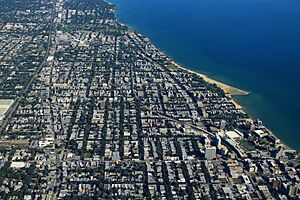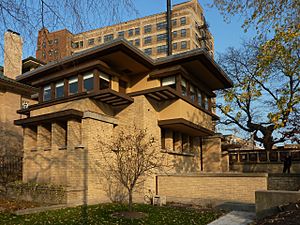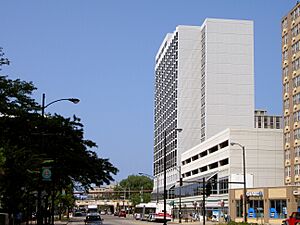Rogers Park, Chicago facts for kids
Quick facts for kids
Rogers Park
|
|
|---|---|
| Community Area 01 – Rogers Park | |

Rogers Park (Chicago, Illinois)
|
|
| Country | United States |
| State | Illinois |
| County | Cook |
| City | Chicago |
| Neighborhoods |
List
Rogers Park
Loyola University Glenwood Arts District East Rogers Park Jarvis Square South/East Evanston East Ridge North Ridge/North Rogers Park North of Howard (NoHo) |
| Area | |
| • Total | 1.84 sq mi (4.76 km2) |
| Population
(2020)
|
|
| • Total | 55,628 |
| • Density | 30,270/sq mi (11,687/km2) |
| Demographics (2020) | |
| • White | 44.3% |
| • Black | 27.1% |
| • Hispanic | 18.9% |
| • Asian | 5.4% |
| • Other | 4.3% |
| Educational Attainment (2020) | |
| • High School Diploma or Higher | 88.3% |
| • Bachelor's Degree or Higher | 47.2% |
| Time zone | UTC-6 (CST) |
| • Summer (DST) | UTC-5 (CDT) |
| ZIP Codes |
60626, 60645
|
| Median Household income (2020) | $46,244 |
| Source: U.S. Census, Record Information Services | |
Rogers Park is a lively neighborhood on the North Side of Chicago, Illinois. It is one of Chicago's 77 official community areas. Located about 9 miles north of downtown Chicago, it sits right on the shore of Lake Michigan.
Rogers Park is known for its beautiful green spaces, old buildings from the early 1900s, and fun places like theaters, restaurants, and beaches. It is a very diverse community, meaning people from many different backgrounds live there. The Chicago Sun-Times newspaper even said it is the Chicago community that best represents the city's mix of cultures.
The neighborhood is bordered by Evanston to the north, Ridge Boulevard to the west, Devon Avenue and the Edgewater neighborhood to the south, and Lake Michigan to the east. A part of Rogers Park, called West Ridge, used to be part of it until the 1890s. Today, Loyola University Chicago has its main campus in the southeastern part of the neighborhood, right by the lake.
Contents
History of Rogers Park
Rogers Park was first settled where two old Native American trails met. These trails later became Rogers Avenue and Ridge Boulevard. The Pottawatomi and other local tribes lived in Rogers Park during different seasons. You can still see this history in names like Indian Boundary Park and Pottawattomie Park.
Early Settlements and Growth
In 1809, the Karthauser Inn opened as a stop for stagecoaches. Later, Phillip Rogers from Ireland bought a lot of land here between the 1830s and 1856. He had a toll gate near his home and often worked with the local tribes.
From 1844 to 1850, new settlers started farms on a ridge in the western part of Rogers Park. They avoided the lower areas to the east, which often flooded. In 1870, Rogers' son-in-law, Patrick I. Touhy, sold 100 acres to land investors. These investors, along with Touhy, formed the Rogers Park Building and Land Company in 1873. Many streets in the area are named after these early investors.
Also in 1873, the Chicago & Northwestern Railway built a train line through the area. They built a station at Greenleaf Avenue. By then, about 200 people lived there, and a post office opened.
Becoming a Village and Joining Chicago
On April 29, 1878, people voted to make Rogers Park an official village in Illinois. It was run by six trustees. In 1885, another railroad, the Chicago, Evanston & Lake Superior, built a line through eastern Rogers Park. This line is now part of the "L" train system.
By 1893, the population grew to 3,500. The North Shore Electric Railroad also expanded its service. In the same year, the village of Rogers Park became part of Chicago. The first library opened in 1894, started by the Rogers Park Women's Club. Sadly, a big fire in 1894 destroyed the main business area.
Rogers Park in the 20th Century
By 1904, the population reached 7,500. The Northwestern elevated train line was extended to Howard Street. St. Ignatius College moved to the lakefront in 1912 and became Loyola University in 1915.
By 1930, Rogers Park had 57,094 people, making it one of Chicago's most crowded areas. In the 1930s, many Chicagoans started moving to new communities outside the city. This led to German, English, Irish, and Jewish families moving into Rogers Park. After World War II, even more immigrants came to Chicago and settled in Rogers Park. Since 2000, a growing and lively Hispanic community has developed along Clark Street.
Rogers Park Today
Rogers Park is Community Area #1 in Chicago. It is located on the far north side of the city, about 9 miles from the Loop, which is downtown Chicago.
Population and Diversity
| Historical population | |||
|---|---|---|---|
| Census | Pop. | %± | |
| 1910 | 8,722 | — | |
| 1920 | 26,857 | 207.9% | |
| 1930 | 57,094 | 112.6% | |
| 1940 | 60,565 | 6.1% | |
| 1950 | 62,252 | 2.8% | |
| 1960 | 56,888 | −8.6% | |
| 1970 | 60,759 | 6.8% | |
| 1980 | 55,525 | −8.6% | |
| 1990 | 60,378 | 8.7% | |
| 2000 | 63,484 | 5.1% | |
| 2010 | 54,991 | −13.4% | |
| 2020 | 55,628 | 1.2% | |
Rogers Park has many residents with advanced college degrees, more than the state average. Also, almost twice as many people here work for nonprofit groups compared to the rest of Illinois.
According to the 2020 U.S. census, Rogers Park residents are 45.1% white, 24.3% Black, 19.5% Hispanic, and 5.1% Asian. Another 5.8% belong to two or more races. This mix makes it the Chicago community that best reflects the city's overall population. About 34% of Rogers Park residents were born outside the United States.
Economy and Culture
Loyola University Chicago is a very important school in Rogers Park. It is located in the southeast part of the community. Interesting historical places include Madonna Della Strada Chapel and the Mundelein Center for the Fine and Performing Arts. The Mundelein Center is one of the tallest Art Deco buildings in Chicago outside of downtown. Many Jesuit religious groups are still in Rogers Park, but the neighborhood also has many other religious institutions.
Because of the many students and professors from Loyola University Chicago and Northwestern University nearby, Rogers Park has always been a very open-minded and accepting place. The community also has a strong online presence. In 2007, a website called outside.in named Rogers Park one of the "bloggiest neighborhoods" in the country.
Rogers Park has over 130 restaurants, coffee shops, and cafes. It is considered "very walkable," meaning it's easy to get around on foot. The neighborhood is also home to the Glenwood Sunday Market, a farmers market that sells local and organic foods. The Chicago Comedy Film Festival takes place every year at The New 400 Theaters, bringing filmmakers and actors from all over the world.
Many beaches line the shores of Lake Michigan throughout the neighborhood. The Artists of the Wall festival is held at the Farwell Avenue pier. During this event, community members paint murals on benches along the lake. This festival has been happening for over twenty years, making it the longest-running event of its kind in Chicago.
The Luxembourg Brotherhood of America used to hold an annual event called Schobermesse in Rogers Park. This event stopped for a while but has been happening again since 2001.
Schools and Libraries
The Chicago Public Schools system runs several schools in Rogers Park:
- Zoned schools for kindergarten through 8th grade include: Gale Elementary Community Academy, Eugene Field Elementary School, Joyce Kilmer Elementary School, George B. Swift Elementary Specialty School, George B. Armstrong School of International Studies, and Jordan Community Elementary School.
- Most of Rogers Park is served by Roger C. Sullivan High School, while a small part goes to Senn High School.
Other schools include:
- Chicago Math and Science Academy
- PACTT Learning Center
- UNO Rogers Park Charter School (a type of public school run independently)
Private schools in the area are:
- Northside Catholic Academy Elementary School
- Northside Catholic Academy Middle School
For higher education, City Colleges of Chicago offers community college courses, and Loyola University Chicago has its Lake Shore Campus here.
Rogers Park has several libraries:
- The Rogers Park Branch of the Chicago Public Library
- Cudahy Library at Loyola University, which is mainly for students but open to the public
- Gerber/Hart Library and Archives, which focuses on LGBT books and materials
The neighborhood is also home to the Leather Archives and Museum.
Getting Around Rogers Park
Public transportation in Rogers Park is provided by the Chicago Transit Authority (CTA). This includes the Chicago 'L' train system and bus routes. A commuter train service, Metra, also serves the area.
Rogers Park has three 'L' train lines: the Red, Yellow, and Purple lines. There are four Red Line stations: Howard, Jarvis, Morse, and Loyola. The Yellow Line and Purple Line connect at Howard Station. From there, you can travel west to Skokie (Yellow Line) or north to Evanston and Wilmette (Purple Line).
The Howard Street 'L' station is the northernmost CTA train stop in Chicago. It was greatly improved between 2006 and 2009 and is now a major transportation hub for the northern Chicago area. Several bus routes can take you to downtown Chicago (the Loop) and to nearby suburbs. These include the 22 Clark, 96 Lunt, 97 Skokie, 147 Outer Drive Express, 151 Sheridan, 155 Devon, and 201 Central/Ridge routes.
The Metra commuter train has a stop called Rogers Park at Lunt and Ravenswood Avenues. This station is very popular and one of the most used stops in the Metra system.
The community has also worked to make it easier to walk and bike around. Through community meetings, a project was created to improve bicycle paths. This included adding buffered bike lanes, raised crosswalks, and traffic circles. These improvements help connect residents to popular spots like Loyola University, 'L' stations, and schools by bike.
Famous People from Rogers Park

Many notable people have lived in or have connections to Rogers Park:
- Mitch Altman, a hacker and inventor.
- Manda Aufochs Gillespie, an author.
- Sadhu Aufochs Johnston, a city manager.
- Betty Ford, a former First Lady of the United States.
- Lara Flynn Boyle, an actress who spent her childhood here.
- Eula Biss, an author.
- Shani Davis, an Olympic speed skater.
- Hugh Downs, a TV personality.
- Tina Fey, an actress and comedian, lived here in the early 1990s.
- Edward Gorey, an illustrator, spent his childhood here.
- Shecky Greene, a comedian, attended Sullivan High School.
- Marion Mahony Griffin, an architect who helped design Canberra, Australia's capital.
- Mary Maher, a journalist and activist.
- Neil Hartigan, a former Lieutenant Governor and Attorney General of Illinois, is a lifelong resident.
- Hampar Kelikian, an orthopedic surgeon and activist.
- Dan Kotowski, a state senator.
- Vivian Maier, a famous street photographer.
- Clayton Moore, the actor known for playing The Lone Ranger.
- Marisol Nichols, an actress.
- David Orr, a politician.
- Fritz Pollard, an NFL Hall of Fame coach.
- Harold Ramis, an actor, writer, and director.
- Dan Savage, a writer, spent his childhood here.
- Jan Schakowsky, a U.S. House of Representatives member, grew up in Rogers Park.
- Genndy Tartakovsky, an animator and director.
- Burr Tillstrom, a puppeteer who created Kukla, Fran and Ollie.
- Laken Tomlinson, an American football player in the NFL.
- Lucas Jade Zumann, an actor.




